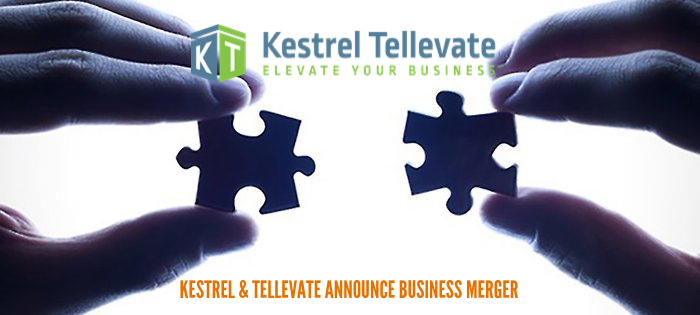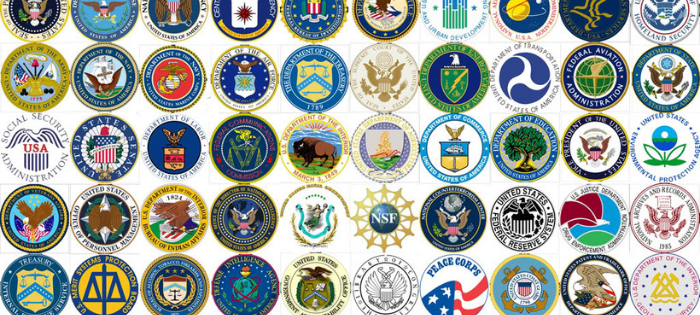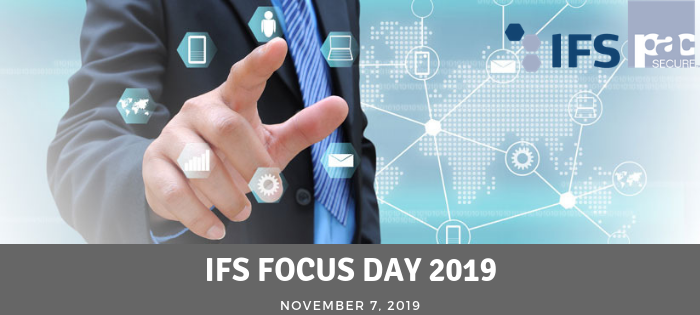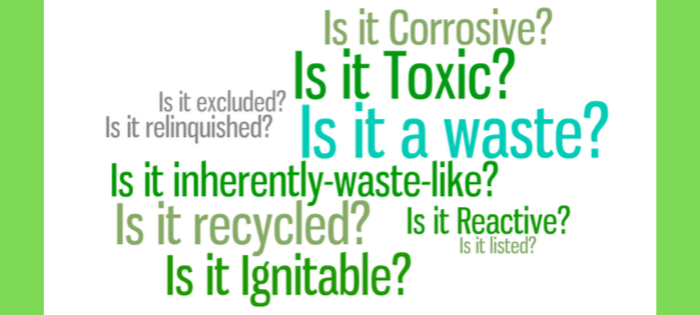
How Do I Efficiently Sustain Waste Management Compliance?
Understanding your waste requirements and then getting your facility in compliance with those requirements are important steps in your waste management efforts. However, effective waste management is not a one-time effort. It takes ongoing resources and tools to sustain ongoing compliance. Consider the following:
- How do you track your waste inventory?
- Do you have ongoing permitting requirements to manage?
- Does your staff need periodic training?
- Are there regular (e.g., annual, semi-annual) plans and/or reports you need to submit?
- Do you have routine inspections and monitoring?
- How do you maintain your records? Where do you house your documentation?
Managing all these things and effectively resourcing ongoing regulatory compliance needs can quickly become overwhelming—especially for those companies without a dedicated team of full-time environmental, health and safety (EHS) staff.
Technology Tools
Documenting waste management procedures and processes, along with management oversight and continual review and improvement, is key to ensuring ongoing compliance. Technology (i.e., a compliance information management system (IMS), apps, tools) can help create process standardization, operational efficiencies, and, subsequently, consistent and reliable compliance/waste management performance.
However, it must be noted that applying technology to operations isn’t about just finding and buying a software tool. It is about:
- Understanding the business need;
- Customizing and integrating the appropriate tool into existing operations; and
- Deploying it so it is effectively applied.
Scalable Solutions
Virtually every regulatory program, including those related to waste management, has compliance requirements that call for companies to fulfill a number of common compliance activities. While they do not necessarily need to be addressed all at once or from the start, considering the eight functions of compliance when designing compliance efficiency tools helps define the starting point and build a vision for the end result.
Compliance efficiency tools built on an Office 365 platform offer an adaptable/scalable solution that can allow you to more efficiently manage compliance tasks, corrective and preventive actions (CAPAs), and other project activities to ensure you are meeting your compliance requirements. Translating these common compliance functions into modules that can be instrumental in establishing or improving a company’s capability to comply, including:
- Facility profiles
- Waste inventories
- Compliance calendars
- Assessments & inspections
- Mobile forms & checklists
- Audit tracking
- Permit management/tracking
- Document and records management
Adding Business Value
In the end, implementing compliance efficiency tools such as this can provide the resources needed to effectively manage your waste management program—plus a number of other lasting benefits to the overall business:
- Helps improve the company’s capability to comply on an ongoing basis
- Establishes compliance practices
- Creates a strong foundation for internal and 3rd-party compliance audits and for answering outside auditors’ questions (agencies, customers, certifying bodies)
- Helps companies know where to look for continuous improvement
- Reduces surprises and unnecessary spending on reactive compliance-related activities
- Informs management’s need to know
- Enhances confidence of others (e.g. regulators, shareholders/investors, insurers, customers), providing evidence of commitment, capability, reliability and consistency in the company’s waste management program

Comments: 1 Comment
Kestrel & Tellevate Announce Business Merger
We are excited to announce that Kestrel Management LLC (Kestrel) and Tellevate LLC (Tellevate) have merged to provide enhanced compliance and management consulting services to industry and government agencies. The newly merged entity will be conducting business as Kestrel Tellevate LLC (KTL) as of November 1, 2019.
Partnership History
Kestrel and Tellevate have a long-standing relationship dating back to 2011. “Our companies’ proactive partnership strategy has allowed us to quickly assemble the right resources to respond efficiently to changing cilent needs and ensure successful projects,” explains Joseph Tell, KTL Principal. “Formalizing this partnership through a merger will allow us to create more efficiencies in our business to bring more value to our clients and elevate their operations and business processes.”
Each entity brings resources and expertise to KTL to enhance the newly formed company’s ability to provide more comprehensive services to both industry and government. “Kestrel has a 20+-year history providing environmental, health, safety, quality, and food safety consulting services to a diverse group of industrial clients,” says KTL Principal Evan Fitzgerald. “Tellevate brings an extensive background in providing EHS management solutions to both industry and government contracts. This is a merger that will allow KTL to grow in both markets and to better serve our clients.”
What This Means for You
Your daily interactions and existing contracts with Kestrel Management LLC or Tellevate LLC will remain largely unchanged. Going forward, there may be some new faces (and expertise) to join your project team. Any future changes to our existing systems/process will be communicated to you, as needed.
Together, KTL will continue to help our clients reduce operational risks, assure regulatory compliance, and implement reliable management systems for continual improvement in the areas of environment, health & safety, food safety, and quality. We provide comprehensive services to both industrial clients and government agencies in the following areas:
- EHS Compliance Assurance
- Process, Program & Project Improvement
- Management Systems
- Food Safety Certification & Compliance
- Information Management Solutions
Logistics
The new entity’s primary branches are located in Decatur, Georgia; and Madison, Wisconsin; with satellite offices in Chicago, Illinois; Des Moines, Iowa; Ann Arbor, Michigan; St. Louis, Missouri; Milwaukee, Wisconsin; and Washington, D.C. Additional information can be found at https://kestreltellevate.com.

Comments: No Comments
2019 NACD Annual Meeting: Nov. 11-14, 2019
Partnering with NACD

Comments: 1 Comment
Compliance & Commissioning for Food-Grade Products
All materials that are part of the food supply chain, including food packaging and contact materials, can significantly influence food safety. Inadequate packaging can fail to protect food properly or allow for contamination or adulteration. Producing safe food demands food safety management and compliance from all who contribute to the final food packaging and contact materials—those supplying materials, making the packaging, manufacturing food contact materials, and distributing the final packaged products.
Setting the Standard
Under the Global Food Safety Initiative (GFSI) standards, major schemes (e.g., IFS PACsecure, the BRC Global Standard for Packaging, SQF Packaging, and FSSC 22000) provide guidance for the producers of packaging materials to ensure the safety and quality of food and non-food products.
The GFSI standards are described as different but equal. It is important that companies determine the best fit of the GFSI options for their own company requirements. All of the standards help manufacturers, packers/fillers, and retailers demonstrate that every reasonable measure has been taken to avoid a food safety incident. Qualified legal reviews have shown that these GFSI benchmarked standards also meet nearly all of the food safety requirements of FDA/FSMA.
The GFSI standards address the requirements to assure food safety by applying the Hazard Analysis and Critical Control Points (HACCP) and Good Manufacturing Practice (GMP) principles specific to food packaging risk and this sector of the food industry. The standards help manufacturers take responsibility by establishing a recognized Food Safety Management System (FSMS).
Each food packaging standard follows a defined documentation program for GFSI certification, and may fit specific packaging applications and food risk differently. As a general example, the FSSC 22000 certification scheme uses ISO 22000 and PAS 223 to identify the requirements for certification and to define a set of food safety requirements, as listed in sections 4-8 of the standard (see table below).
| 4. Food Safety System Requirements | 4.1. Establish an FSMS
4.2. Document your FSMS |
| 5. Food Safety Management Requirements
|
5.1. Demonstrate a commitment to food safety
5.2. Establish your food safety policy 5.3. Plan your FSMS 5.4. Clarify your FSMS responsibilities and authorities 5.5. Appoint a food safety team leader 5.6. Establish your communications 5.7. Develop emergency response procedures 5.8. Carry out FSMS management reviews |
| 6. Food Safety Resource Requirements | 6.1. Provide adequate FSMS resources
6.2. Provide adequate human resources 6.3. Provide adequate infrastructure 6.4. Provide adequate work environment |
| 7. Food Safety Realization Requirements
|
7.1. Manage the realization of safe products
7.2. Establish your prerequisite programs (PRPs) 7.3. Get ready to do a hazard analysis 7.4. Perform your organization’s hazard analysis 7.5. Establish your operational PRPs 7.6. Establish your HACCP plan 7.7. Update preliminary documents and programs 7.8. Plan and perform your verification activities 7.9. Establish a product traceability system 7.10. Control your nonconforming products |
| 8. Food Safety Confirmation Requirements
|
8.1. Confirm and improve food safety methods
8.2. Validate food safety control measures 8.3. Control your monitoring & measuring methods 8.4. Verify your FSMS 8.5. Improve your FSMS |
Preparing for Certification
Taking measures upfront to adhere to food safety standards helps assure that food packaging will meet in-use demands and regulatory requirements so that the food contents can be enjoyed safely. To prepare for certification, companies should:
- Identify regulatory requirements, which may include commissioning of plant and equipment to confirm compliance with food safety requirements
- Set clear target dates for assessment and implementation
- Establish an informed and thorough materials evaluation process
- Identify and document food safety hazards and relevant control measures (HACCP/GMP)
- Identify applicable GMPs (e.g., pest control, equipment & building maintenance, housekeeping & cleaning)
- Establish a robust FSMS that aligns with existing management systems (i.e., quality, environmental, health & safety)
- Implement any needed structural improvements
- Institute ongoing material and packaging testing protocols, as well as strict handling and use requirements
Case Study: Food-Grade Paper Mill
Kestrel has been involved with a number of paper and packaging facilities considering expanding production operations to manufacture food-grade product that meets GFSI, FSSC 2200, GMP, HACCP, and customer requirements. The following provides an example of how a Kentucky-based paper mill commissioned its site to manufacture paper products to meet the needs of food customers nationwide.
Phase 1: HACCP/GMP Compliance Analysis
Due to the recent changes in regulatory and certification requirements, this paper mill needed to be confirmed or commissioned as food-material compliant to continue its food-grade materials manufacturing. Building on its existing management system documentation, originally designed and certified to ISO 9001, the mill determined that it would comply with FDA food contact paper requirements and sought alignment with the GFSI FSSC 22000 standard.
Kestrel conducted a preliminary GMP/HACCP certification analysis to provide a third-party audit report on the mill’s compliance to regulatory and industry standards. The desktop, physical site, and process reviews included analysis of the following:
- Site HACCP program
- Risk analysis assessment
- GMP requirements under FDA
- Supplier program and receipt of goods
- Customer requirements and release of goods
- CAPA management
- Food safety objectives/policy
Based on this assessment, Kestrel established a project workplan and estimated timeline to develop and implement a food safety management program for both FDA and GFSI FSSC 22000 certification requirements.
Phase 2: GMP/HACCP FSMS
The mill proceeded with establishing the required programs for compliance to regulatory and industry standards for the manufacture of food-grade product meeting the processing requirements under GMP and HACCP. Specific project goals for this phase included:
- Designing and implementing a sustainable and compliant FSMS
- Developing a system that fully complies with all the FDA and industry (GFSI/HACCP) programs, procedures, and metrics
- Using a design and implementation process that draws from existing business/management systems and documentation
- Using a process that actively engages the workforce in the design/development, implementation, and ongoing improvement activities of the FSMS to create a participative food-safe packaging culture
- Using a scalable design and implementation process that is responsive to the company’s resources
Kestrel began this phase of the project by focusing on foundational management system elements and working stepwise through the GMP and HACCP programs. Project tasks included:
- Completing food safe packaging compliance register
- Conducting physical review
- Developing HACCP/preventive controls plan
- Creating GMP requirements list
- Developing food safety plan policies/procedures
- Determining second level procedures and work instructions
- Developing/providing training modules
- Conducting internal audits
- Starting management reviews
- Commencing program integrity audits and status updates
- Integrating with current corrective actions and management processes
- Starting FSSC certification process (staged)
Kestrel’s most recent review and assessment of the mill’s management systems and approaches to food safety standards indicate that the overall business integrity and compliance is at the highest level in respect to food safety packaging standards. A legal review has confirmed that the process and developed programs also meet food safety legal requirements.
Benefits
The flexible packaging industry has experienced rapid growth. Ongoing innovation has led to more new materials being used, growth in packaging formats, extreme in-use conditions, and increasingly more stringent FDA regulations and food safety standards. Commissioning plants for food safety is vital to operating within the food industry.
A company’s achievement as a reliable supplier is linked to its capability to provide safe products. In addition, adhering to food safety standards:
- Allows manufacturers to report on their status to key stakeholders (e.g., food retailers, customers)
- Covers areas of hygiene and product safety throughout the packaging industry
- Helps ensure that suppliers are also following good hygiene practices to complete the due diligence chain
- Ensures that a sustainable quality and product safety system is established and continually improved

Environment / Quality / Safety
Comments: No Comments
Partnering with Government Agencies to Manage Projects
From time to time, private businesses are faced with the prospect of partnering with a government agency, office, or department in order to accomplish a goal or undertake a project. Reasons vary: the effort may result from an enforcement action, consent order, or settlement agreement, or it may simply be a strategic priority that requires joining forces with a federal, state, or local government office. In any case, working with government agencies presents opportunities and challenges not regularly encountered in a competitive business’s projects.
Reset Your Clock
Government agencies do not move at the speed of competitive business—they typically move much slower. Government budgeting and spending are intentionally lengthy processes that are subject to the political winds. As a result, it is not unusual for agencies to employ (legacy) infrastructure and systems that have worked in the past, regardless of apparent inefficiencies today.
If the agency will be contributing financially to the effort, it may take years for funding to be proposed, studied, discussed, approved in a budget, and then approved to spend. Similarly, any decision-making can be an arduous and lengthy process involving a multitude of managers and influencers.
Understanding how funding and decisions are made and who needs to be involved is critical to managing the time element of projects. Often, the dominant motive for decision-making is protection of the status quo and personal job security, versus “let’s try something new and exciting”. Stakeholder management requires understanding, patience, and persistence.
Take the Lead
Business should expect to take the lead in project management. Most government agencies will advertise successful projects after they are completed, but will keep unproven or work-in-progress low key, pending successful results. Similarly, they will participate as directed in the work but do not usually want to be viewed as driving a public-private partnership, as even the appearance of an overly close relationship with a particular business can compromise the agency’s perceived objectivity. Finally, many public agencies do not have trained project managers on staff to lead such an effort, while a business may.
Find an Agency Champion
Successful execution of the project plan requires timely coordination and cooperation from the agency, and may involve a number of different departments or functions within it. For example, building a joint facility may involve facilities, IT, security, finance, law, and operations departments. In order to get the cooperation needed from the various departments, those staffs will expect someone in their direct chain of command to prioritize the project.
In competitive business, a Vice President acting as project sponsor may have all the authority he/she needs to expect and get cooperation across the property. But in a government agency, a Director or Section Chief over one of the areas may carry absolutely no authority in another department. Government agencies tend to be very silo-ed in their structures, not matrixed. It is important to find a sponsor far enough up the chain to cover all areas involved and to communicate his support of the project to all areas—even if he/she is not regularly directly involved in the project.
Build a Lasting Relationship
So often, the only time business and agencies interact is when one needs something from the other. This can lead to a strained relationship, characterized by avoidance or begrudging interactions. These are the same agencies, however, where a positive working relationship can result in a business competitive advantage. Working closely with these gatekeepers of the regulations and public trust in a non-confrontational setting can set the foundation for a new relationship built upon mutual understanding and achieving common goals.
Government employees fill a valuable role in society by providing services and protecting society. Besides understanding the current enforcement priorities, they interact with customers, competitors and even employees, and can provide valuable information or ideas for businesses to improve efficiencies or help direct the focus of current business efforts.
Case Study: Utility Environmental Management System (EMS)
Kestrel managed a project with an investor-owned utility to design and implement an Environmental Management System (EMS) at a coal-fired power plant. The result of a consent order from the state Natural Resources Department, both the utility and the agency were involved from design and implementation to final auditing and EMS acceptance by the agency. The project and the associated agency interactions brought the plant higher confidence in its environmental plans and operations, and gave local regulators a deeper understanding of the utility business and ownership of the plant’s path forward.
Takeaways
Working with a government agency to manage a project is different than working with a competitive business. However, doing so can be beneficial to achieving both parties’ objectives if the company knows how to successfully navigate the working relationship:
- Understand how government funding and decisions are made before project kickoff.
- Actively manage government stakeholders—expect to take the lead.
- Find a project sponsor with the authority to ensure cooperation from all agency departments involved.
- Take advantage of the opportunity to build a positive, long-lasting relationship.

Comments: No Comments
How Do Business Processes Impact Waste Management?
Biotechnology Focus
When it comes to digging deeper into your waste management efforts, it’s important to step back from the waste itself and consider how waste fits into operations—and how it may impact your overall business. What’s coming in? What’s going out? And what risks does this present to the business?
In this Q&A with KTL Principal Lisa Langdon, we discuss how a comprehensive review of operations is the foundation to effectively managing waste.
What does a comprehensive review of operations look like?
Companies who want to proactively manage their waste need to first go through the process of understanding:
- What waste streams you have;
- Where your waste fits into your business processes; and
- What you need to do with your waste and operations to minimize risk, reduce costs, and ensure compliance.
The first step in understanding how waste fits into the business is to thoroughly review and map all business processes, keeping focus on the entire production process. This can start with a facility layout diagram, followed by more specific process and sub-process flow diagrams.
Most biotech operations will have their processes mapped in a fair amount of detail, but perhaps not smaller or startup operations. For example, existing diagrams might be found as part of the documents managed under a quality management systems (QMS) (e.g., ISO 9001) or as part of air permitting or other compliance documents.
As an outside consultant, Kestrel reviews and builds off whatever process flows have already been developed internally to ensure they are comprehensive. The review and process flows should reflect production-related activities, including raw materials receiving, raw material entry and processing in production, product finishing, packaging, and shipping. Capability, capacity, programs, and processes to comply are examined as part of this review.
How does this help a company understand and improve waste management?
Defining, understanding, and improving the material and waste flow within major processes, programs, and projects can be challenging. Through in-depth interviews, data analysis, application of disciplined process improvement methods, and facilitation, we are able to demonstrate how all areas interrelate and impact the way an organization functions—as well as the associated business risks.
Having this all mapped out helps companies improve the interconnected set of processes, sub-processes, activities, and tasks that allow the business to manage waste most effectively. With a comprehensive understanding of a process, program or project, it then becomes possible to make changes that reduce variation and remove activities that contribute no value to the end product or service.
What is the goal on a waste management project like this?
Ultimately, our goal is to help companies decide on priorities for change, and then implement efficient business processes to improve operations and waste management practices that our clients can manage on their own. We maintain our focus on increasing efficiency and reliability without sacrificing quality, capacity, safety, or environmental responsibility.
Kestrel’s forte lies in translating strategy into execution, using process as the critical link to help organizations realize measurable results. By providing an objective perspective, we assist company leaders in analyzing, documenting, operationalizing, and sustaining process, program, and project improvements over the long term.

Top 5 Critical Factors for Value-Added Auditing
Auditing is a management tool that can be used to evaluate and monitor the internal performance and compliance of your company with regulations and standards. An audit can also be used to determine the overall effectiveness of an existing system within your company.
How do you incorporate compliance auditing best practices to help maximize compliance, efficiency, and value of your audit? Here are five critical factors for value-added audits.
1. Goal Aligned with Business Strategy
There are many reasons why companies conduct audits:
- Support commitment to compliance
- Avoid penalties
- Meet management system requirements
- Meet corporate or customer mandates
- Support acquisition or divestiture
- Assess organizational structure and competency
- Identify cost saving and pollution prevention opportunities
- Determine alignment with strategic direction
It is vital to define and understand the goal of your compliance audit program before beginning the audit process. Establishing goals enables recognition of broader issues and can lead to long-term preventive programs. Not establishing a clear, concise goal can lead to a waste of resources.
Audit goals and objectives should be nested within the company business goals, key performance objectives, and values. An example of a goal might be to effectively measure environmental compliance while maintaining a reasonable return on investment.
Once the goal is established, it is important to communicate it across all functions of the organization to get company-wide support. Performance measurements should also be communicated and widely understood.
2. Management Buy-in
The audit program must have upper management support to be successful. Management must exhibit top-down expectations for program excellence, view audits as a tool to drive continuous improvement, and work to imbed audits within other improvement processes. Equally important, management must not use audit results to take punitive action against any person or department.
3. Documented Audit Program Systematically Applied
Describe and document the audit process for consistent, efficient, effective, and reliable application. Audit procedures should be tailored to the specific facility/operation being audited. A documented program will include the following:
- Scope. The scope discusses what areas/media/timeframe will be audited. The scope of the audit may be limited initially to what is manageable and can be done very well, thereby producing performance improvement and a wider understanding and acceptance of objectives. It may also be limited by identifying certain procedural or regulatory shifts and changes. As the program is developed and matures (e.g., management systems, company policy, operational integration), it can be expanded and, eventually, shift over time toward systems in place, prevention, efficiency, and best practices. It is important at the scoping stage to address your timeline. Audits should be scoped to make sure you get them done but also to make sure you have audited all compliance areas in an identified timeframe.
- Criteria. Compliance with requirements will clearly be covered in an audit, but what about other opportunities for improvement (e.g., pollution prevention, energy savings, carbon reduction)? All facilities need to be covered at the appropriate level, with emphasis based on potential compliance and business risks. Assess the program strengths, redundancy, integration within the organization, and alignment with the program goal. Develop specific and targeted protocols that are tailored to operational characteristics and based on applicable regulations and requirements for the facility. As protocols are updated, the ability to evaluate continuous improvement trends must be maintained.
- Auditor training (i.e., competency, bias). A significant portion of the audit program should be conducted by knowledgeable auditors (e.g., independent insiders, third parties, or a combination thereof) with clear independence from the operations being audited and from the direct chain of command. For organizational learning and to leverage compliance standards across facilities, it is good practice to vary at least one audit team member for each audit. Companies often enlist personnel from different facilities and with different expertise to audit other facilities. Periodic third-party audits further bring outside perspective and reduce tendencies toward “home-blindness”.
Training should be done throughout the entire organization, across all levels:
+ Auditors are trained on both technical matters and program procedures.
+ Management is trained on the overall program design, purpose, business impacts of findings, responsibilities, corrections, and improvements.
+ Line operations are trained on compliance procedures and company policy/systems.
Consider having auditor training conducted by an outside source to teach people how to decide what to audit and follow a trail. It can also work well to train internal auditors by having them audit alongside an experienced 3rd party.
- Audit conduct (i.e., positive approach). A positive approach and rationale for the audit must be embraced. Management establishes this tone and sets the expectation for cooperation among all employees. Communication before, during, and after the audit is vital in keeping things positive. It is important to stress the following:
- Auditor interviews are evaluating systems, not personal behaviors.
- The audit is an effective tool to improve performances.
- Results will not be used punitively.
- Audit reporting. Information from auditing (e.g., findings, patterns, trends, comparisons) and the status of corrective actions often are reported on compliance dashboards for management review. Audit reports should be issued in a predictable and timely manner. It is desirable to orient the audit program toward organizational learning and continual improvement, rather than a “gotcha” philosophy. “Open book” approaches help learning by letting facility managers know in advance what the audit protocols are and how the audits will be conducted. Documentation is essential, and reporting should always align with program goals and follow legal guidance. There is variability in what gets reported and how based on the company’s objects. For example:
- Findings only vs. opportunities for improvement and best management practices?
- Spreadsheet vs. long format report?
- Scoring vs. prioritization of findings (beware of the unintended consequences of scores!)?
- Recommendations for corrective actions included or left for separate discussion?
- Corrective and preventive action. Corrective actions require corporate review, top management-level attention, and management accountability for timely completion. A robust root cause analysis helps ensure not just correction/containment of the existing issue, but also preventive action to assure controls are in place to prevent the event from recurring. For example, if a drum is labeled incorrectly, the corrective action is to relabel that drum. A robust plan should be to also look for other drums that might be labeled incorrectly and to add and communicate an effective preventive action (e.g., training or posting signs showing a correctly labeled drum).
- Follow-up and frequency. Address repeat findings. Identify patterns and seek root cause analysis and sustainable corrections. Communications with management should be done routinely to discuss status, needs, performance, program improvements, and business impacts. Those accountable for performance need to be provided information as close to “real time” as possible. There are several levels of audit frequency, depending on the type of audit:
- Frequent: Operational (e.g., inspections, housekeeping, maintenance) – done as part of routine day-to-day operational responsibilities
- Periodic: Compliance, systems, actions/projects – conducted annually/semi-annually
- As needed: For issue follow-up
- Infrequent: Comprehensive, independent – conducted every three to four years
4. Robust Corrective Action Program
As mentioned above, corrective actions are a must. If there is no commitment to correction, there is no reason to audit. A robust root cause analysis is essential. This should be a formal, yet flexible, approach. There should be no band-aids. Mistake-proof corrections and include metrics where possible. In the drum example given above, a more robust corrective action program would look at the root cause: Why was the drum mislabeled? Did the person know to label it? If so, why didn’t they do it?
The correction itself is key to the success of the audit program. Establish the expected timeframe for correction (including addressing preventive action). Establish an escalation process for delayed corrections. Corrective actions should be reviewed regularly by upper management using the existing operations review process. There must also be a process for verification that the correction has been made; the next audit cycle may not be sufficient.
Note also that addressing opportunities for improvement, not just non-compliance findings, may increase the return on investment associated with conducting an audit.
5. Sharing of Findings and Best Practices
Audit results should be communicated to increase awareness and minimize repeat findings. Even if conducted under privilege, best practices and corrections can and should still be shared. Celebrate the positives and creative solutions. Stress the value of the audit program, always providing metrics and cost avoidance examples when possible. Inventory best practices and share/transfer them as part of audit program results. Use best-in-class facilities as models and “problem sites” for improvement planning and training.
Value-Added Audit
An audit can provide much additional value and return on organization if it is planned and managed effectively. This includes doing the following:
- Align program goal with business strategy to secure top-down buy-in
- Expand criteria beyond compliance
- Gain goodwill through positive approach
- Document program and results
- Monitor for timely, effective corrective action
- Share opportunities for improvement

Comments: No Comments
IFS Focus Day Is Back: November 7, 2019
Don’t miss this FREE educational opportunity to network with industry peers,
IFS representatives, consultants & IFS PACsecure auditors.
IFS Focus Day
November 7, 2019 | 8:30 a.m. – 3:00 p.m.
Hilton Los Angeles Airport Hotel | Los Angeles, CA
REGISTER NOW!
Meet the IFS team to learn about IFS and how they support packaging suppliers through the implementation of the IFS PACsecure Standard requirements.
Learn about chemical migration in packaging; FSMA and how it relates to packaging; how to perform effective and efficient risk assessments.
Hear firsthand from an IFS PACsecure-certified packaging supplier why he chose IFS and the benefits the company has enjoyed since achieving certification.
Who Should Attend?
This IFS Focus Day is for you if you are a:
- Packaging supplier considering a packaging safety certification, already certified with IFS, or in the process of implementing the IFS PACsecure Standard.
- Brand owner wanting to learn about how the IFS PACsecure Standard can reduce your packaging supplier audits, improve quality, and keep your products safe.
- Retailer looking for certifications that will ensure the safety and traceability of your products through the entire supply chain.
Space is limited, attendance is free! Don’t miss out!
(Lunch to be provided.)

Comments: 3 Comments
What Wastes Do I Have & What EHS Regulations Apply?
BIOTECHNOLOGY FOCUS
Waste regulations can be difficult to understand, and it can be challenging to comply. Regulatory citations often seem like they are in a different language and the terminology used by inspectors can be confusing and difficult to decipher. Compliance often requires speaking not only the lab/industry language, but also the regulator’s language.
To get a true understanding of what regulations apply, it is important to start by asking two fundamental questions:
- What wastes does my company generate?
- What activities does my company carry out that are covered by waste requirements?
Through an evaluation of chemicals onsite, development of an inventory of both chemicals used and waste generated, and identification of processes to efficiently and effectively manage waste, businesses/labs can ensure they understand and meet their EHS regulatory obligations in the most efficient ways possible.
Environmental Protection Agency (EPA): Where Do You Start?
EPA regulates much of the waste generated by industry. Over the past ten years, the Agency has demonstrated an even stronger focus on labs. The most commonly cited EPA penalties under the Resource Conservation and Recovery Act (RCRA), which governs the disposal of solid and hazardous waste, have resulted from the items listed below:
- Dumping hazardous wastes down the drain
- Not having or having inadequate hazardous waste manifests
- Failing to properly train employees in hazardous waste management, handling, and emergency preparedness
- Lack of or improper labeling
- Open containers of hazardous waste onsite
- Failing to comply with hazardous waste generator regulations
- Improperly managing expired paints or spray paints
- Failing to have hazardous waste determinations on file
- Improper consolidation of waste from other nearby facilities
- Noncompliance with underground storage tank regulations
In order to avoid these citations, it is important to first understand your wastes. This is done through an EPA-required waste determination. In addition to reviewing chemicals that are used in processes and the different types of risk they present, a waste determination should evaluate all waste being generated by processes throughout the facility. The following waste streams are of particular regulatory concern, as they have strict regulatory requirements for their management and disposal.
Hazardous Waste
Hazardous wastes are found in a variety of processes in labs and in industry. Solvents used to operate equipment, chemicals to conduct reactions and create products, maintenance chemicals, and new innovations are all potential sources of hazardous waste and should be included in a comprehensive waste determination.
The most frequently generated hazardous waste type in labs and in industry is flammable liquids. Chemicals such as acetone, toluene, xylenes, and methanol are commonly used flammable liquids that must be managed as hazardous waste. These wastes cannot be dumped down the drain without significant risk of fire, danger to personnel, and regulatory penalty. One of the first questions a regulator will ask in a lab or industrial process setting is to see waste containers. If a facility has chemicals but no waste containers, the regulators immediately jump to the conclusion that waste is not being managed correctly.
Other common hazardous waste streams found in labs and industry include toxic chemicals; corrosive acids and caustic bases; reactive chemicals, such as oxidizers and polymerizing chemicals; and chemicals that are radioactive. All of these are regulated by compliance agencies and require special management.
Examples of EPA regulations applying to labs include such things as identification of the amount of hazardous waste generated in a calendar month by a lab or in industry. The more hazardous waste generated, the more rigorous the EPA regulations.
Universal Waste
EPA also regulates a class of waste referred to as universal waste. Universal wastes are hazardous in their composition but can be recycled (e.g., fluorescent lightbulbs or lamps, CRTs and electronic waste, rechargeable batteries, and mercury-containing items). Failure to collect, label, store, and recycle these types of waste properly can also result in substantial threat of compliance penalty.
EPA regulators have focused on these waste streams as a source of penalty for the past decade. This is one of the most frequent citations issued to businesses. Although not as complex as the requirements for proper hazardous waste management, universal waste has nuances that a generator must be aware of to properly meet the regulatory requirements.
Biohazardous, Sharps, Pharmaceuticals, Unwanted Equipment, and Other Waste Types
Labs and industry have many additional sources of waste that are confusing and present head-scratching challenges as a waste determination is conducted. For example:
- If a facility wants to remove an outdated x-ray machine or electron microscope from service, what are the compliance requirements and is there a way to recycle it?
- If a lab process results in debris that is contaminated with bodily fluids, can they just be thrown in the trash? At what point are they considered “biohazardous?”
Beyond EPA
Additional regulatory agencies that oversee lab and industry operations include the Occupational Safety & Health Administration (OSHA), Department of Transportation (DOT), Department of Homeland Security (DHS), fire department, and others depending upon the type of work being done, chemicals being used, and resulting end products. As with EPA, identifying the other regulations that apply can be quite challenging and overwhelming. For example:
- Under OSHA, evaluation of worker personal protective equipment (PPE), respiratory protection, safety equipment, including safety showers and eye wash stations, and fire extinguishers requires plans, inspections, and training of workers. These programs should be set up as best practice to protect employees.
- As discussed in our previous article, DOT is often forgotten about in labs; however, there are general DOT requirements for any entity receiving or shipping hazardous materials. Failure to have proper DOT training or to know how to properly ship can result in significant financial penalty.
The waste scenarios seen in labs and industry are countless, and each may hold associated regulatory compliance requirements. While this clearly presents business risks, it also provides a unique opportunity to create strategies to manage wastes more effectively and efficiently, improve safety, and reduce the potential costs of regulatory compliance.

Comments: No Comments
24-hr OSHA HAZWOPER Training: November 2019
OSHA1910.120 (HAZWOPER) requires any employees who are in positions that may respond to chemical spills or emergencies onsite be trained in chemical risk recognition, spill control basics, emergency response, and additional requirements depending on the level of response expected.
24-hour OSHA HAZWOPER Initial Technician Training
November 5-7, 2019
8 am – 4:30 pm daily
Fairfield Inn & Suites | 215 NE Delaware Ave. | Ankeny, Iowa
REGISTER NOW!
Kestrel’s 24-hour OSHA HAZWOPER Initial Technician Training is offered as a 3-day, hands-on course. Participants will learn how to recognize basic hazard classes, read labels and use SDS to understand risk, use engineering controls or PPE to prevent exposure, address field analytical equipment, and correctly respond to spills and implement emergency response site plans.
Topics covered include:
- OSHA requirements
- Basic hazard classes
- Hazard communication
- Personal Protective Equipment (PPE)
- Respiratory protection
- Spill Control, Containment, and Countermeasures (SPCC)
- Emergency response
- EPA regulatory overlap
Cost: $495/participant; includes lunch and snacks. Participants will receive a certificate of training completion, course guide, and resource collection of OSHA support materials.
Training Details
- Training session will be held at Fairfield Inn & Suites | 215 NE Delaware Ave. | Ankeny, Iowa.
- Training is scheduled to begin at 8:00 am and end at 4:30 pm daily (or until material is complete).
- Snack and lunch will be provided.
- Participants will receive a training manual, pre-/post-competency test, exercises, and a certificate of completion, provided they receive an 80% or above on the test.

